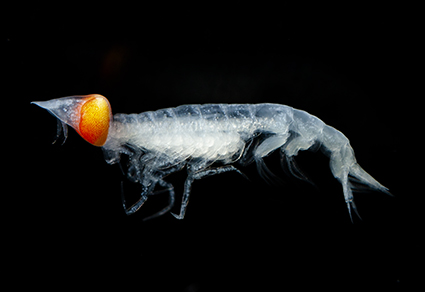Abstract
A new species of Glossocephalus, G. aurantium sp. nov., is described based on two female specimens collected from the Monterey Canyon, California, eastern Pacific Ocean. It was found associated with an undescribed lobate ctenophore. Glossocephalus aurantium is readily distinguished from its congeners by the large crescent-shaped bulbous eye fields relative to the size of the head capsule. The pereopod morphology is most similar to G. rebecae, recently described from the same general region by Zeidler and Browne (2015), but that species is readily distinguished by it’s relatively narrow crescent-shaped eye fields. Apart from it’s prominent bulbous eye structures, G. aurantium is distinguished from G. milneedwardsi by the morphology of the gnathopods (not spoon-shaped). In addition, pereopods 5 and 6 are slender (not paddle-like) and the head capsule is relatively larger with a sharp rostrum (not rounded).
References
Bovallius, C. (1887) Systematical list of the Amphipoda Hyperiidea. Bihang till Kungliga Vetenskaps-Akademiens Handlingar, 11 (16), 1–50. https://doi.org/10.5962/bhl.part.5127
Browne, W.E., Haddock, S.H.D. & Martindale, M.Q. (2007) Phylogenetic analysis of lineage relationships among hyperiid amphipods as revealed by examination of the mitochondrial gene, cytochrome oxidase 1 (CO1). Integrative and Comparative Biology, 47, 815–830. https://doi.org/10.1093/icb/icm093
Gasca, R. & Browne, W.E. (2018) Symbiotic associations of crustaceans and a pycnogonid with gelatinous zooplankton in the Gulf of California. Marine Biodiversity, 48, 1767–1775. https://doi.org/10.1007/s12526-017-0668-5
Gasca, R., Hoover, R. & Haddock, S.H.D. (2015) New symbiotic associations of hyperiid amphipods (Peracarida) with gelatinous zooplankton in deep waters off California. Journal of the Marine Biological Association of the United Kingdom, 95, 503–511. https://doi.org/10.1017/S0025315414001416
Haddock, S.H.D., Christianson, L.M., Francis, W.R., Martini, S., Dunn, C.W., Pugh, P.R., Mills, C.E., Osborn, K.J., Seibel, B.A., Choy, C.A., Schnitzler, C.E., Matsumoto, G.I., Messié, M., Schultz, D.T., Winnikoff, J.R., Powers, M.L., Gasca, R., Browne, W.E., Johnsen, S., Schlining, S.v-T., Erwin, B.E., Ryan, J.F. & Thuesen, E.V. (2017) Insights into the biodiversity, behavior, and bioluminescence of deep-sea organisms using molecular and maritime technology. Oceanography, 30, 38–47. https://doi.org/10.5670/oceanog.2017.422
Hurt, C., Haddock, S.H.D. & Browne, W.E. (2013) Molecular phylogenetic evidence for the reorganization of the hyperiid amphipods, a diverse group of pelagic crustaceans. Molecular Phylogenetics and Evolution, 67, 28–37. https://doi.org/10.1016/j.ympev.2012.12.021
Laval, P. (1980) Hyperiid amphipods as crustacean parasitoids associated with gelatinous plankton. Oceanography and Marine Biology, Annual Review, 18, 11–56.
Milne-Edwards, H. (1830) Extrait de recherches pour servir à l’histoire naturelle des Crustacés Amphipodes. Annales des Sciences Naturelles, 20, 353–399, pls. 10–11. https://doi.org/10.5962/bhl.part.12300
Spence Bate, C. (1861) On the morphology of some Amphipoda of the Division Hyperina. The Annals and Magazine of Natural History, Series 3, 8 (43), 1–16, pls. 1–2. https://doi.org/10.1080/00222936108697372
Zeidler, W. & Browne, W.E. (2015) A new Glossocephalus (Crustacea: Amphipoda: Hyperiidea: Oxycephalidae) from deep-water in the Monterey Bay region, California, USA, with an overview of the genus. Zootaxa, 4027 (3), 408–424. https://doi.org/10.11646/zootaxa.4027.3.5


